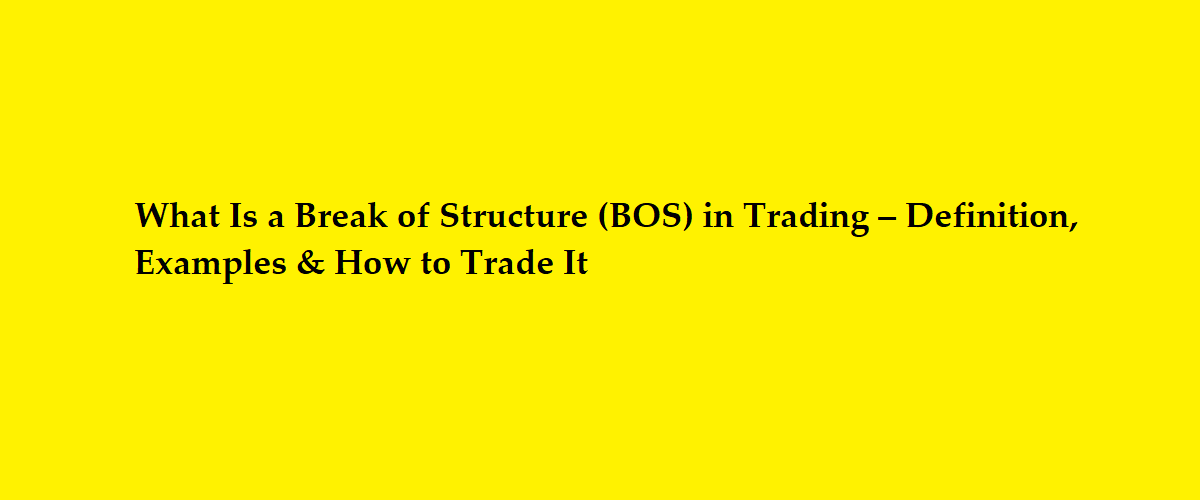A Break of Structure (BOS) is one of the most important concepts in price action trading. It signals a potential trend continuation or reversal, helping traders spot high-probability entries.
Whether you trade forex, stocks, or crypto, understanding BOS can significantly improve your trading accuracy. In this guide, we’ll break down:
✔ What a BOS is (with examples)
✔ How to identify valid vs. false breaks
✔ The best trading strategies using BOS
✔ Common mistakes to avoid
Let’s dive in!
What Is a Break of Structure (BOS)?
A Break of Structure (BOS) occurs when price clearly violates a swing high or swing low, indicating a shift in market momentum.
Two Types of BOS:
- Bullish BOS: Price breaks a swing high, signaling uptrend continuation.
- Bearish BOS: Price breaks a swing low, signaling downtrend continuation.
Why BOS Matters:
- Confirms trend strength
- Helps spot early reversal opportunities
- Used in ICT, Smart Money, and Algo Trading strategies
How to Identify a Valid Break of Structure
Not all breaks are equal. A true BOS must have:
1. A Clear Swing Point Break
- Price must close beyond the swing high/low (not just wick).
- Example: In an uptrend, a new higher high (HH) confirms bullish BOS.
2. Follow-Through Momentum
- After the break, price should continue in the same direction.
- A weak break that reverses quickly = false BOS (liquidity grab).
3. Volume & Liquidity Confirmation (For Stocks/Crypto)
- High volume increases validity.
- In forex, watch for order flow imbalances.
Top Trading Strategies Using BOS
1. Trend Continuation Entries
- Strategy: Wait for BOS in trend direction → Enter on pullback.
- Example: In an uptrend, buy at OTE (62-79% Fib retracement) after a new HH.
2. Reversal Trading (With MSS Confirmation)
- Strategy: BOS + Market Structure Shift (MSS) = High-probability reversal.
- Example: Downtrend breaks LL, then forms a higher low (HL) → Potential reversal.
3. Fakeout & Liquidity Grab Trades (ICT Style)
- Strategy: Price breaks structure but reverses → Fade the break.
- Example: Stop hunts at key levels before a reversal (Turtle Soup strategy).
Best Markets & Timeframes for Trading BOS
| Market | Best Timeframes | Why It Works |
|---|---|---|
| Forex (EUR/USD) | 1H, 4H, Daily | Strong trends, clear structure |
| S&P 500 (ES Futures) | 15M, 1H | High liquidity, institutional moves |
| Bitcoin (BTC/USD) | 4H, Daily | Volatile, strong breakouts |
Common BOS Trading Mistakes
❌ Trading Every Break (Wait for confirmation!)
❌ Ignoring Higher Timeframe Structure (HTF BOS > LTF noise)
❌ No Risk Management (Always use stop loss!)
Example Trades: Bullish vs. Bearish BOS
Bullish BOS Example (EUR/USD Daily)
- Price forms higher lows (HL) in uptrend.
- Finally breaks previous swing high (HH).
- Pulls back to OTE zone, then rallies → Buy opportunity.
Bearish BOS Example (BTC/USD 4H)
- Price makes lower highs (LH) in downtrend.
- Breaks last swing low (LL) with momentum.
- Retests breakdown level → Short entry.
Conclusion
A Break of Structure (BOS) is a powerful trading signal that helps confirm trends, reversals, and liquidity sweeps. By mastering BOS, you can:
✅ Avoid false breakouts
✅ Catch early trend shifts
✅ Trade like smart money
🚀 Want to practice BOS trading? Check out the latest charting tools and broker offers to get started today!
FAQs
1. What’s the difference between BOS and MSS?
- BOS = Break of Structure (price breaks swing point).
- MSS = Market Structure Shift (confirms trend change, e.g., HH → HL).
2. Can I use BOS for scalping?
Yes, but higher timeframes (1H+) provide more reliable signals.
3. How do I avoid fake BOS breakouts?
Wait for candle close beyond the level + follow-through momentum.
4. Which indicators work best with BOS?
- Volume Profile (for stocks/crypto)
- Fibonacci retracements (for pullback entries)
5. Is BOS used in algo trading?
Yes! Many algorithms track swing breaks for momentum trades.

1 thought on “What Is a Break of Structure (BOS) in Trading – Definition, Examples & How to Trade It”